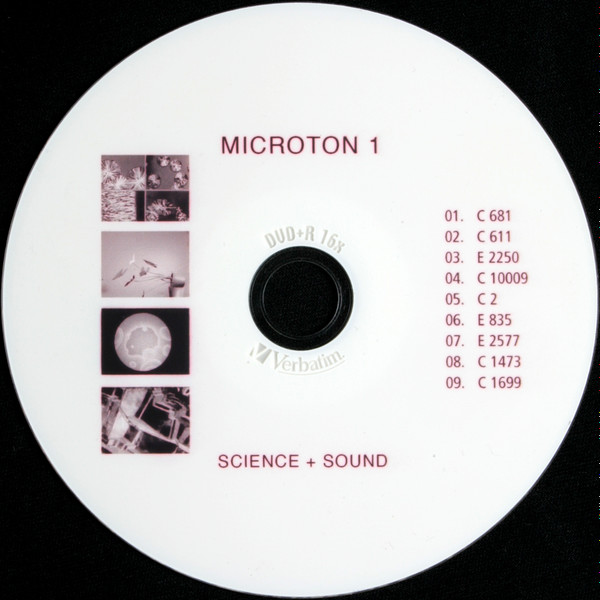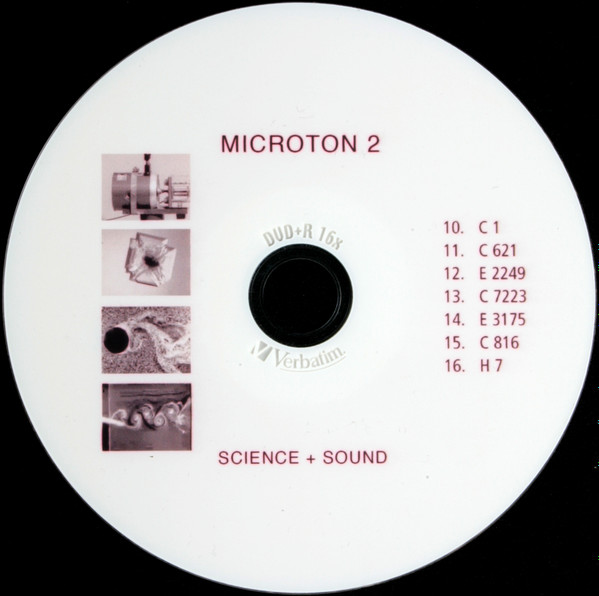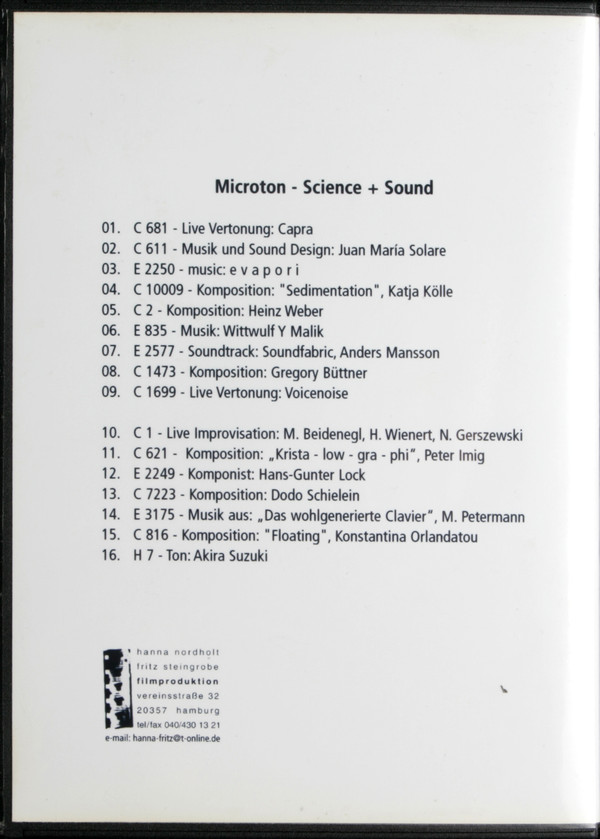MusiQ
Various - Microton ScienceSound
Table of Contents
Download
Filename: various-microton-sciencesound.rar- MP3 size: 126.4 mb
- FLAC size: 748.8 mb
Tracks
| Track | Duration | Preview |
|---|---|---|
| C 10009 ("Sedimentation") | ||
| C 2 | ||
| E 2249 | ||
| E 3175 ("Das Wohlgenerierte Clavier") | ||
| C 611 | ||
| H 7 | ||
| C 816 ("Floating") | ||
| C 1473 | ||
| C 681 (Live Vertonung) | ||
| E 835 | ||
| C 7223 | ||
| E 2577 | ||
| C 1699 (Live Vertonung) | ||
| C 621 ("Krista - Low - Gra - Phi") | ||
| E 2250 | ||
| C 1 (Live Improvisation)) |
Images




Labels
Hanna Nordholt, Fritz Steingrobe FilmproduktionListen online
- lytte på nettet
- online luisteren
- écouter en ligne
- ascolta in linea
- lyssna på nätet
- kuunnella verkossa
- ouvir online
- escuchar en línea
- online anhören
Formats
2 × DVDrNotes
- For the 23rd Short Film Festival in Hamburg 2007 Hanna Nordholt and Fritz Steingrobe selected 16 science short movies without sound and asked 16 musicians/ensembles to make a soundtrack.
- At the 10th June the works was presented at the Metropolis cinema. Some artsist performed live.
- After the show they produced this double DVDr with all films only as thank you for the artists (one each person).
- Text for the evening from the festival website:
- "There is a song asleep in all things"
- Film is too versatile to be left to storytellers. In the beginning of the history of cinema, there were engineers, scientist and inventors. The earliest manifestations of the scientific film are chronophotography and the segmentation of movement into single pictures. In the early 20th century, several institutes started to systematically observe processes by using cameras and projectors. Insights are gained especially when the whole scope of filmic technology, like fast motion, slow motion, and multiple exposure, is applied Just like microscopes ventured into ever smaller universes, film technology advanced and uncovered pictures, which shaped and represented the 20th century in a special way. For the fine arts, there are many sources of inspiration here.
- In the MICROTON programme, we want to show that the scientific film has a structural relationship with music. For this experiment, 16 international composers and sound researchers have busied themselves with process films from the last 70 years. Some works will be performed live in the Metropolis cinema that night, others will be played on CD. The spectrum of sounds ranges from a vocal ensemble to electronic compositions.
- Three films of the programme concern themselves with the phenomena of water and its formation of turbulences.
- Peter Imig, who set a film about growth of crystals to sound, writes: "Crystalography is one of the classic fields of study of harmonies: mirror planes, straight edges, precise corners - these attributes of naturally grown crystals permit the conjecture that matter is not shaping into arbitrary shapes, but that the sub structure is represented by strictly defined laws of shape and proportions. These laws can be examined as to whether they can be experienced as harmonies in music as well."
- In addition, we can quote Leibniz: "Music is the pleasure the human mind experiences from counting without being aware that it is counting.". And no physicist of our day and age would contradict Pythagoras, who said that "a rock is music turned into stone".
- The scientific film which examines and analyses processes has its counterpart in the work of researchers, who examine acoustic phenomena with their equipment and who create references with new combinations, which haven't been heard that way before. Oliver Peters' (EVAPORI) work has been created in this spirit, and it will add a new dimension to a film about the change of molecular structures in metal.
- Sounds are values of both the soul and mathematics, and as such, it seems logical that the look through the electronic microscope can have its musical equivalence. The atoms dance and the planetary systems resonate in great harmony and we sense how "The sun-orb sings, in emulation, 'Mid brother-spheres, his ancient round", as Goethe once wrote.
- The outcome of the experiment regarding the "Sound of Science" remains to be seen and its effects can not be estimated yet. By listening to the intervals and accords, you may possibly feel a great calm and get a glimpse of the things that make us resonate beyond the profane. As David Lynch once said: " If you look at cinema merely as a money making machine, you will realize that all innovations will be lost.".
- We thank all composers and sound researchers, the electronic studio of the Music- and Theatre Academy Estonia, the IWF and the Max-Planck Institute for the permission to screen the films as part of the MICROTON project.
